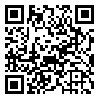Thu, Dec 4, 2025
| فارسی
Volume 18, Issue 3 (Autumn 2016)
Advances in Cognitive Sciences 2016, 18(3): 1-17 |
Back to browse issues page
Download citation:
BibTeX | RIS | EndNote | Medlars | ProCite | Reference Manager | RefWorks
Send citation to:



BibTeX | RIS | EndNote | Medlars | ProCite | Reference Manager | RefWorks
Send citation to:
Rafiei-Atani T, Hashemi-Namin M, Jahed-Motlagh M, Minaei-Bidgoli B. A Computational Model of Creative Mental Imagery Inspired by Islamic Philosophy. Advances in Cognitive Sciences 2016; 18 (3) :1-17
URL: http://icssjournal.ir/article-1-500-en.html
URL: http://icssjournal.ir/article-1-500-en.html
Tayebe Rafiei-Atani1 
 , Mojdeh Hashemi-Namin2
, Mojdeh Hashemi-Namin2 
 , Mohammad-Reza Jahed-Motlagh2
, Mohammad-Reza Jahed-Motlagh2 
 , Behrouz Minaei-Bidgoli *2
, Behrouz Minaei-Bidgoli *2 


 , Mojdeh Hashemi-Namin2
, Mojdeh Hashemi-Namin2 
 , Mohammad-Reza Jahed-Motlagh2
, Mohammad-Reza Jahed-Motlagh2 
 , Behrouz Minaei-Bidgoli *2
, Behrouz Minaei-Bidgoli *2 

1- Artificial Intelligence, Iran University of Science and Technology, Tehran, Tehran, Iran.
2- Iran University of Science and Technology, Tehran, Iran.
2- Iran University of Science and Technology, Tehran, Iran.
Abstract: (3098 Views)
Objective: Three types of images can be considered in the mind: Remembering images which have already been seen, making abstract image from all images of a concept already existing in the mind or creating new images for new concepts using existing images and concepts. “Creative Imagery” refers to the latter.
Method: Computational modelling of Imagery – as a cognitive process – describes mechanisms and processes of imagery. It embodies the description based on computer science. In this paper, the process of human creative imagery is described using Islamic Philosophy approach.
Results: According to the Islamic Philosophy, Imaginative faculty can compose and decompose concepts (existing in memory) and forms (existing in Imaginative Faculty) for Creative Mental Imagery. Role of Imaginative Faculty can be modeled with a multi-level probabilistic algorithm. As an example, running path of the algorithm for creating image of “tree with eye and mouth” is shown. The computational model is able to produce those images which human produce for the new concept.
Conclusion: Creating new image uses composition of basic elements (forms and concepts). Thus for modelling creative imagery two fundamental aspects should be considered: Appropriate representation of forms and concepts and discovery and modeling mental processes combining these components.
Method: Computational modelling of Imagery – as a cognitive process – describes mechanisms and processes of imagery. It embodies the description based on computer science. In this paper, the process of human creative imagery is described using Islamic Philosophy approach.
Results: According to the Islamic Philosophy, Imaginative faculty can compose and decompose concepts (existing in memory) and forms (existing in Imaginative Faculty) for Creative Mental Imagery. Role of Imaginative Faculty can be modeled with a multi-level probabilistic algorithm. As an example, running path of the algorithm for creating image of “tree with eye and mouth” is shown. The computational model is able to produce those images which human produce for the new concept.
Conclusion: Creating new image uses composition of basic elements (forms and concepts). Thus for modelling creative imagery two fundamental aspects should be considered: Appropriate representation of forms and concepts and discovery and modeling mental processes combining these components.
Keywords: Computational Model, Creative Imagery, Imaginative Faculty, Artificial Intelligence, Islamic Philosophy
Type of Study: Research |
Subject:
Special
Received: 2017/11/27 | Accepted: 2017/11/27 | Published: 2017/11/27
Received: 2017/11/27 | Accepted: 2017/11/27 | Published: 2017/11/27
| Rights and permissions | |
 |
This work is licensed under a Creative Commons Attribution-NonCommercial 4.0 International License. |

